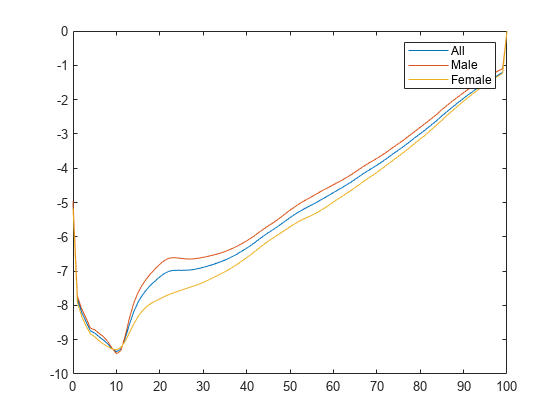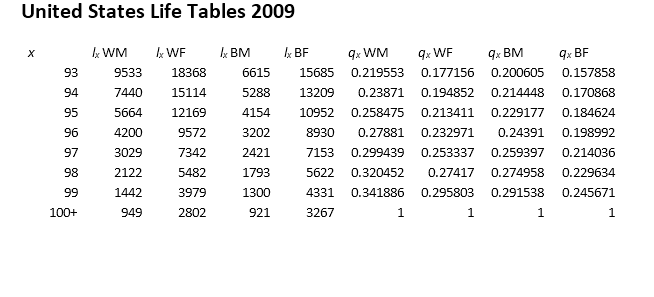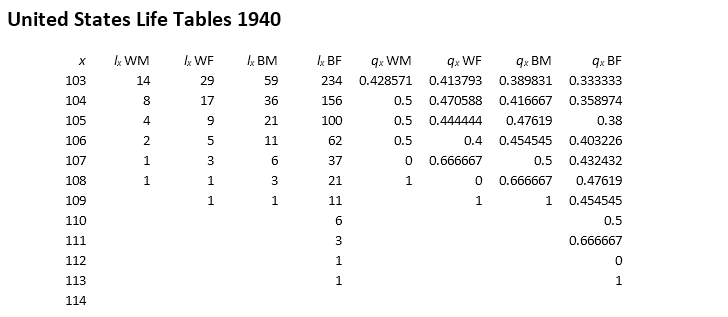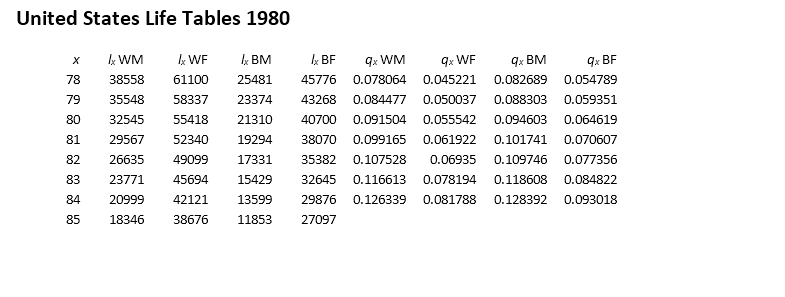lifetableconv
Convert life table series into life tables with forced termination
Description
Examples
Load the life table data file.
load us_lifetable_2009Convert life table series into life tables with forced termination.
[qx,lx,dx] = lifetableconv(x,lx); display(qx(1:20,:))
0.0064 0.0070 0.0057
0.0004 0.0004 0.0004
0.0003 0.0003 0.0002
0.0002 0.0002 0.0002
0.0002 0.0002 0.0001
0.0001 0.0002 0.0001
0.0001 0.0001 0.0001
0.0001 0.0001 0.0001
0.0001 0.0001 0.0001
0.0001 0.0001 0.0001
0.0001 0.0001 0.0001
0.0001 0.0001 0.0001
0.0001 0.0001 0.0001
0.0002 0.0002 0.0002
0.0003 0.0004 0.0002
0.0004 0.0005 0.0002
0.0005 0.0006 0.0003
0.0005 0.0007 0.0003
0.0006 0.0009 0.0004
0.0007 0.0010 0.0004
display(lx(1:20,:))
1.0e+05 *
1.0000 1.0000 1.0000
0.9936 0.9930 0.9943
0.9932 0.9926 0.9939
0.9930 0.9923 0.9937
0.9927 0.9920 0.9935
0.9926 0.9919 0.9933
0.9924 0.9917 0.9932
0.9923 0.9916 0.9931
0.9922 0.9914 0.9930
0.9921 0.9913 0.9929
0.9920 0.9912 0.9928
0.9919 0.9911 0.9927
0.9918 0.9910 0.9926
0.9917 0.9909 0.9925
0.9915 0.9907 0.9923
0.9912 0.9903 0.9921
0.9908 0.9898 0.9919
0.9904 0.9892 0.9916
0.9899 0.9885 0.9913
0.9892 0.9876 0.9909
display(dx(1:20,:))
637.2266 698.8750 572.6328
40.4062 43.9297 36.7188
27.1875 30.0938 24.1406
20.7656 23.0781 18.3359
15.9141 17.2109 14.5625
14.8672 16.3125 13.3516
13.3672 14.7891 11.8750
12.1328 13.3828 10.8203
10.8125 11.6094 9.9844
9.4609 9.5781 9.3438
8.6172 8.1328 9.1172
9.2656 8.8359 9.7188
12.5938 13.5078 11.6328
19.1016 22.9844 15.0234
27.6719 35.5938 19.3516
36.6328 48.5703 24.0547
45.0156 60.7109 28.4844
53.1406 72.8906 32.2812
60.8984 85.1172 35.2578
68.3438 97.2266 37.6875
Plot the qx series and display the legend. The series qx is the conditional probability that a person at age x will die between age x and the next age in the series.
plot(x,log(qx)) legend(series)

Load the life table data file.
load us_lifetable_2009Calibrate life table from survival data with the default Heligman-Pollard parametric model.
a = lifetablefit(x,lx)
a = 8×3
0.0005 0.0006 0.0004
0.0592 0.0819 0.0192
0.1452 0.1626 0.1048
0.0007 0.0011 0.0007
6.2843 6.7637 1.1038
24.1387 24.2895 53.1783
0.0000 0.0000 0.0000
1.0971 1.0987 1.1100
Generate life table series from the calibrated mortality model.
qx = lifetablegen((0:120),a); display(qx(1:20,:))
0.0063 0.0069 0.0057
0.0005 0.0006 0.0004
0.0002 0.0003 0.0002
0.0002 0.0002 0.0002
0.0001 0.0001 0.0001
0.0001 0.0001 0.0001
0.0001 0.0001 0.0001
0.0001 0.0001 0.0001
0.0001 0.0001 0.0001
0.0001 0.0001 0.0001
0.0001 0.0001 0.0001
0.0001 0.0001 0.0001
0.0002 0.0002 0.0001
0.0002 0.0002 0.0002
0.0002 0.0003 0.0002
0.0003 0.0004 0.0002
0.0004 0.0005 0.0002
0.0005 0.0006 0.0003
0.0006 0.0008 0.0003
0.0007 0.0009 0.0003
Convert life table series into life tables with forced termination.
[~,~,dx] = lifetableconv((0:120),qx,'qx');
display(dx(1:20,:))630.9924 686.9527 571.6098 48.7928 55.1029 40.9870 24.8018 26.3778 23.6167 17.0832 17.5878 17.0317 13.6181 13.8188 13.6143 11.8662 12.0076 11.6314 10.9782 11.1573 10.4905 10.5996 10.8604 9.9488 10.5757 10.9396 9.8952 10.8789 11.3612 10.2718 11.6084 12.2508 11.0418 12.9921 13.9271 12.1763 15.3478 16.8835 13.6482 18.9936 21.6793 15.4300 24.1390 28.7665 17.4943 30.8004 38.3215 19.8134 38.7713 50.1489 22.3603 47.6532 63.6909 25.1099 56.9300 78.1270 28.0386 66.0576 92.5258 31.1259
Plot the dx series and display the legend. The series dx is the number of people who die out of 100,000 alive at birth between age x and the next age in the series.
plot((0:119),dx(1:end-1,:)); legend(series, 'location', 'northwest'); title('\bfLife Table Yearly Decrements'); xlabel('Age'); ylabel('Number Dying within a Given Year');

Input Arguments
Increasing ages for raw data, specified as nonnegative integer values in
an N0 vector.
The vector of ages x must contain nonnegative integer
values. If the input series is the discrete survival function
lx, then the starting age need only be nonnegative.
Otherwise, the starting age must be 0.
Data Types: double
Collection of num standardized survivor series,
specified as an N0-by-num matrix. The
input lx0 series is the number of people alive at age
x, given 100,000 alive at birth. Values of
0 or NaN in the input table
lx0 are ignored.
Data Types: double
Collection of num life table series to be converted,
specified as an N0-by-num matrix. The
default y0 series is lx0.
Data Types: double
(Optional) Type of mortality series for input y0,
specified as a character vector with one of the following values:
'qx'— Input is a table of discrete hazards (qx).'lx'— Input is a table of discrete survival counts (lx).'dx'— Input is a table of discrete decrements (dx).
Whereas the output series have forced termination, the input
series (y0) can have one of several types of termination:
Natural termination runs out to the last person so that
lxgoes to0,qxgoes to1, anddxgoes to0. For more information, see Natural Termination.Truncated termination stops at a terminal age so that
lxis positive,qxis less than1, anddxis positive. Any ages after the terminal age areNaNvalues. For more information, see Truncated Termination.
Data Types: char
Output Arguments
Discrete hazard function, returned as an
N0-by-num matrix with forced
termination. For more information, see Forced Termination.
The series qx is the conditional probability that a
person at age x will die between age x and the next age
in the series.
Discrete survival function, returned as an
N0-by-num matrix with forced
termination. For more information, see Forced Termination.
The series lx is the number of people alive at age
x, given 100,000 alive at birth.
Discrete decrements function, returned as an
N0-by-num matrix with forced
termination. For more information, see Forced Termination.
The series dx is the number of people who die out of
100,000 alive at birth, between age x and the next age in
the series.
More About
A life table is a statistical table used in demography and actuarial science to summarize the mortality experience of a population.
A life table provides a detailed breakdown of the probability of death and survival at various ages, allowing for the analysis of life expectancy and the assessment of the health status of a population.
Most modern life tables have “forced” termination. Forced termination means that the last row of the life table applies for all persons with ages on or after the last age in the life table.
This sample illustrates forced termination.

In this case, the last row of the life table applies for all persons aged 100 or older. Specifically, qx probabilities are 1qx for ages less than 100 and, technically, ∞qx for age 100.
Forced termination has terminal age values that apply to all ages after the
terminal age so that lx is positive, qx is
1, and dx is positive. Ages after the
terminal age are NaN values, although lx and
dx can be 0 and qx can
be 1 for input series. Forced termination is triggered by a
naturally terminating series, the last age in a truncated series, or the first
NaN value in a series.
Before 1970, life tables were often published with data that included all ages for which persons associated with a given series were still alive. Tables in this form have "natural" termination. In natural termination, the last row of the life table for each series counts the deaths or probabilities of deaths of the last remaining person at the corresponding age. Tables in this form can be problematic due to the granularity of the data and the fact that groups of series can terminate at distinct ages. Natural termination is illustrated in the following sample of the last few years of a life table.

This form for life tables poses a number of issues that go beyond the obvious
statistical issues. First, the
lx table on the
left terminates at ages 108, 109, 109, and 113 for the four series in the table.
Technically, the numbers after these ages are 0, but can also be
NaN values because no person is alive after these terminating
ages. Second, the probabilities
qx on the right
terminate with fluctuating probabilities that go from 0 to
1 in some cases. In this case, however, all probabilities are
1qx
probabilities (unlike the forced termination probabilities). You can argue that the
probabilities after the ages of termination can be 1 (anyone
alive at this age is expected to die in the next year), 0 (the
age lies outside the support of the probability distribution), or
NaN values.
Truncated termination occurs with truncation of life tables at an
arbitrary age. For example, from 1970–1990, United States life tables truncated at
age 85. This format is problematic because life table probabilities must either
terminate with probability 1 (forced termination) or discard data
that exceeds the terminating age. This sample of the last few years of a life table
illustrates truncated termination. The raw data for this table is the
lx series. The
qx series is
derived from this series.

This life table format poses problems for termination because, for example, over 27% of the population for the fourth lx series is still alive at age 85. To claim that the probability of dying for all ages after age 85 is 100% might be true but is uninformative. Notwithstanding the statistical issues, however, tables in this form are completed by forced termination.
References
[1] Arias, E. “United States Life Tables.” National Vital Statistics Reports, U.S. Department of Health and Human Services. Vol. 62, No. 7, 2009.
Version History
Introduced in R2015a
MATLAB Command
You clicked a link that corresponds to this MATLAB command:
Run the command by entering it in the MATLAB Command Window. Web browsers do not support MATLAB commands.
选择网站
选择网站以获取翻译的可用内容,以及查看当地活动和优惠。根据您的位置,我们建议您选择:。
您也可以从以下列表中选择网站:
如何获得最佳网站性能
选择中国网站(中文或英文)以获得最佳网站性能。其他 MathWorks 国家/地区网站并未针对您所在位置的访问进行优化。
美洲
- América Latina (Español)
- Canada (English)
- United States (English)
欧洲
- Belgium (English)
- Denmark (English)
- Deutschland (Deutsch)
- España (Español)
- Finland (English)
- France (Français)
- Ireland (English)
- Italia (Italiano)
- Luxembourg (English)
- Netherlands (English)
- Norway (English)
- Österreich (Deutsch)
- Portugal (English)
- Sweden (English)
- Switzerland
- United Kingdom (English)